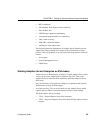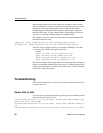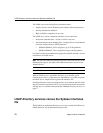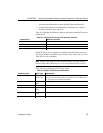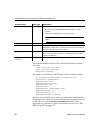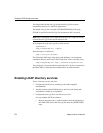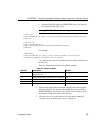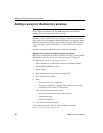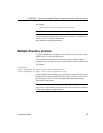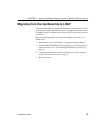
CHAPTER 6 Using the Lightweight Directory Access Protocol as a Directory Service
Configuration Guide 73
In the example above, the entry describes an Adaptive Server named “foobar”
listening on a TCP connection with a port number of 5000. This entity also
specifies a retry count of 12 (times) and a retry delay of 30 (seconds). Once a
client has found an address where a server responds, the login dialog between
the client and the server begins.
You can find a complete list of Sybase’s LDAP directory schema in UNIX
$SYBASE/$SYBASE_OCS/config.
In the same directory, there is also a file called sybase-schema.conf, which
contains the same schema, but uses a Netscape-specific syntax.
Since LDAP supports multiple entries for each attribute, each address attribute
must contain the address of a single server, including protocol, access type, and
address. See
sybaseAddress in Table 6-2.
For example, this is an LDAP entry for an Windows server listening on two
addresses, with different connection protocols:
sybaseAddress = TCP#1#TOEJAM 4444
sybaseAddress = NAMEPIPE#1#\pipe\sybase\query
Note Each entry in the address field is separated by the # character.
You can edit these entries with
dsedit. See “Adding a server to the directory
services” on page 76.
To ensure cross-platform compatibility for all Sybase products, the protocol
and address attribute fields should be in a platform- and product-independent
format.
The libtcl*.cfg file
You use the libtcl*.cfg file to specify the LDAP server name, port number, DIT
base, user name, and password to authenticate the connection to an LDAP
server.
The purpose of the libtcl*.cfg file is to provide configuration information such
as driver, directory, and security services for Open Client/Open Server and
Open Client/Open Server-based applications. 32-bit utilities such as
dsedit and
srvbuild, look up the libtcl.cfg, while 64-bit applications use the libtcl64.cfg file
for configuration information



